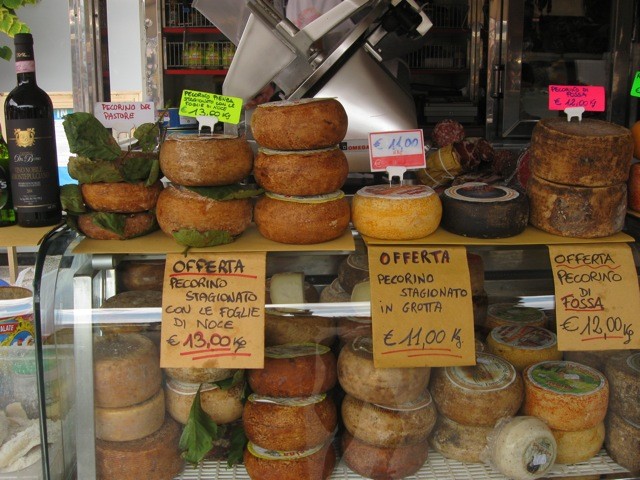Bringing Home Wellness: Souvenirs of Awareness

The gastronomic capital of the world has to be Italy. Everyday life seems to revolve around composing the next meal or, as you travel through the country as a tourist, finding the next market, ristorante, or trattoria.
A long-awaited vacation to Italy with my wife, Deborah, and our dear friends Carolyn and Donnie, created many wonderful memories, and also stimulated awareness of how much we have given up here in America, in terms of quality of food and therefore quality of life. We came back envying the fact that from one end of “the boot” to the other, people enjoy food that is fresh, local, hand-made, and protected from genetic modification, among other things. We came back realizing, that we could, and will modify the way we eat here in The States because a little more than a couple weeks in Italy really elevated our expectations of food.
In June I shared my series on how to really be a “Well Traveler”. Tip number eight was:
Well Travel Tip #8
The best souvenirs…well living ideas to bring back and implement. As you travel, anywhere, be a keen observer HOW people live. Bring home the best observations as ideas for how you can live your life in a better way.
 Everything is fresh at this market in Tuscany.
Everything is fresh at this market in Tuscany.
After buying fresh fruit and vegetable at local markets where the prices were very affordable, and enjoying fresh baked breads, melt-in-your-mouth pastas, and regional cheeses, we came home vowing to find a better way to eat. While we came home with lots of ideas, the challenge will be, of course to implement them.
Italy is a country of about 56 million people and the vast majority do not live in big cities. Rome is only about three million. Milan, Naples and Turin are only a bit over or slightly under one million. It is a country of thousands of small towns. Even in the big cities, however, food is fresh, local and an integral part of living well. It is the remnants of the Feudal System, of just living on the land a long time and making it work that has organized the population, like much of Europe, into more dense living clusters and left most of the landscape open to produce food, if it is arable? On one side of the tracks as we hurdled along on the high-speed Eurostar we saw tightly packed apartments. On the other side, community garden plots in high production. Rooftop gardens in Rome. Window box herbs. We in the U.S. and Canada have sprawled ourselves out into communities that create isolation and total dependence on automobiles. We’ve inhabited basically uninhabitable places with totally artificial water systems (like Las Vegas and Phoenix). We can’t change geography, sociology, or economics overnight, but one of the blessings of travel is stimulating awareness of ways we can improve our own wellness lifestyles here at home.
 Buffalo Mozzarella, fresh tomato, whole basil leaves and olive oil...Yum!
Buffalo Mozzarella, fresh tomato, whole basil leaves and olive oil...Yum!
We’re already opening up these souvenirs of awareness in our lives at home. Last night as our good friend, Maria, visited us and took the lead in cooking dinner. She and Deborah made concrete plans for Maria to teach Deb and a couple of friends how to make their own fresh mozzarella and ricotta cheese, as well as yogurt. Why not have organic, inexpensive and the absolute best tasting food when you can?
I’m delving into why the wheat in Italy did not stimulate my so-called “wheat sensitivity”. After weeks of no symptoms while eating far more wheat than I ever do at home, the first lunch I had here at a popular soup and bread chain restaurant, and I was coughing and sniffling like before the trip. Hmmm? What’s going on? Deb and I are looking at how we can eat less “fooled-with food”.
The “slow food movement” was perhaps birthed in Italy. If you are not in the part of the country that produces basil, or it is past the growing season for it, it will not be on the menu. However the peach you bought at the market was an heirloom variety, indeed tree-ripened, and tasted better than any you ever ate in your life.
Today people around the world are looking into the source of their daily bread, milk, cheese, eggs, etc. They are realizing that shipping food across hundreds, if not thousands of miles is not the answer. It’s an ecological nightmare and we end up with industrialized food that has questionable health qualities and just simply doesn’t taste very good.
As I recounted our journey with wellness expert, and good buddy Meg Jordan (http://www.megjordan.com/) , she posited the idea that perhaps it is that very lack of flavor and freshness that results in Americans overeating. Perhaps because our senses and our emotions are not being satisfied by the food, like they seem to be in a place like Italy, we eat more to feel satiated. We also throw more salt on our food, or salty, sugary condiments like ketchup and BBQ sauce. It Italy salt was rarely on the table. Food was lightly salted in the kitchen and so packed with flavor that what came to the table was perfect just the way it arrived.
What have you brought back with you as wellness souvenirs as you have traveled? What did you realize you could, with fairly little effort, be doing differently in your lifestyle? Was it about food, community, movement, or what? Chime in, and leave your comments. Let’s stimulate a discussion about cross-cultural awareness that can work for us in living healthier lives.








Only registered and logged in readers can leave comments.